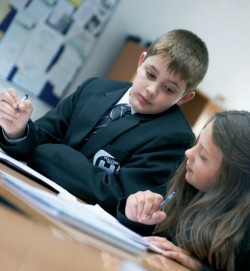Today you will
Investigate the relationship between language use and gender
This lesson uses both language and literature examples to discuss the way that word choice reflects values and influences thought. The topic is a big one and this plan is not intended definitively to ‘sew up’ ideas for the students in a single session. It will be most effective as part of ongoing work in this subject, or as a lead-in to continued or related discussion about the status of different groups in society, and is more suited to Y9 than Y7. The discussion can easily go off at a tangent, and it will be up to the teacher to ensure that it does not stray too far from the central idea of words and their implications. If you wish to allow for more digression, it might be a good idea to take a double for this lesson, or stretch it over two or more learning sessions.
The aim is to introduce the idea that language works to create or emphasise certain roles or attributes according to gender.
What you need
• If students have laptops, they can complete the activities on those, but you may prefer to work with poster size pieces of paper, A3 paper and markers. You might want to emphasise the idea of gender difference by using pink and blue paper for the lists in the ‘starter activity’.
• Copies of the poem ‘Men Talk’ by Liz Lochhead (one per student) – this can be found online. There are also recordings on Youtube of the poet reading it.
• Laminated A4 words from the poem ‘Men Talk’.
• Prepared powerpoint slides as required (e.g. with the key questions on, or one with a couple of empty Venn diagrams on for the starter activity).
Starter activity
Explain to the students that today you will be looking at the different way language is used with reference to males and females: language and gender. There are some key questions to bear in mind during the lesson. Have these up on the Smartboard, if you wish, or have the students write them down:
• Do we use language differently when we are talking about men and women?
• Might repeatedly hearing certain words and phrases about boys and girls affect the way we think about them?
Explain that this is a challenging topic; that students are not expected to have hard and fast opinions by the end of the lesson, but that they should have started thinking about the subject and be prepared to research and discuss it further, if necessary.
As a class, start by talking about the slogans that we sometimes see on clothing for young (pre-school/early primary) children. Focus on the words. What kinds of things are written on tracksuits, T-shirts or even babywear for girls and boys? Hopefully your students will have younger siblings or children they know to whom they can refer. You could ask them what is implied when a girl is given a ‘Future Princess’ or ‘WAG in training’ T-shirt. What are the equivalents for boys? Is there a male term for WAG? What does that tell us?
Ask learners to start thinking about whether these slogans might have an effect, or whether they are simply fun.
Main activities

1. Sticks and stones
Ask the students to start thinking about how language is used once we grow up and go to primary and secondary school. They are going to make some lists of words, in pairs or groups of four. The lists should be of:
(i) words of flattery for girls
(ii) words of flattery for boys
(iii) insults for girls
(iv) insults for boys
The lists should be comprised of individual words (nouns and adjectives) or very short phrases. Let them be as rude as you feel you can tolerate, for the insults. If necessary let them sling out the first few as a class and put these on everyone’s lists.
Get them to do this fairly quickly. They should be able to come up with a good few within five minutes (although the insults may be more forthcoming than the flattery).
Come together as a class to make Venn diagrams. The ‘boy’ and ‘girl’ circles should overlap to provide a space for terms that are aimed at both.
Take some time to focus on the insults and extrapolate from them. Are there any generalisations you can make about what the terms tend to make us think about? E.g. do the insults about girls focus on sexual behaviour? Do there tend to be more ‘animal’ words for girls? Why? Do the flattering words focus more on appearance with girls? If there are some words that are aimed at both, do they mean exactly the same thing in each case (‘bitch’ could be an interesting one here…)?
2. Talk, talk
Read the poem ‘Men Talk’ by Liz Lochhead. If time allows, let students hear the poet read it on Youtube.
Check the students understand the poet’s main idea about how seriously men and women are taken when they speak.
Explain that having analysed the words closely from the previous activity, the students are going to do similar work with the words in the poem.
Hand out the laminated words for ‘women’s speech’ from the poem (e.g. CHATTER, NAG, BABBLE, YATTER, YAP, NIGGLE); one each to pair or group of three or four students.
Ask the students to make three or four statements about what is suggested to them by their word. Here is an example (you could have this on a pre-prepared powerpoint slide):
Gossip
1) Gossip is about things or people in a limited sphere (such as local gossip, school gossip, celebrity gossip)
2) Gossip is not about important matters
3) Gossip might not even be true
4) Gossip might be mean or nasty
Allow about ten minutes for this activity, before moving on to the summary.
Home learning
Here’s a few possible home learning activities, depending on how you would like to progress with this. Choose one and explain it at the end of the lesson(s), or post them for students to choose from (with more detailed explanations) on your VLE.
1. Watch Australian PM Julia Gillard’s attack on opposition leader for sexism and misogyny. Which words does she pinpoint as having offended her as a woman? Why these particular words, do you think? http://tinyurl.com/92w5v8u
2. Rap/ hip-hop is notorious for containing sexist language. Analyse a song you know. What does it show us about attitudes to women? Find an antidote to this. Have female rappers hit back? An older example would be Queen Latifah’s ‘UNITY’. Watch this on Youtube or find a more modern equivalent. http://tinyurl.com/bp49rzf
3. Find out about Mitt Romney’s recent reference to ‘binders full of women’. Why did this phrase so light up the Twittersphere? This article may help, or can be set as a reading assignment (for able students): http://tinyurl.com/btfhn2c
Summary
Bring the class back together to hear the statements about each word in ‘Men Talk’ and encourage students to explain how the words emphasise the poet’s point. You could conclude the discussion in different ways:
1. Through exploration of students’ own experiences.
2. Through re-emphasising the idea that language is not neutral and has the power to shape attitudes and reflect values.
3. Through leading on to the next step: if language is not neutral and has the power to shape attitudes and reflect values, should we regulate its use? ( leading to discussion about hate-speech; censorship; sensitive use of language; ‘PC’).
4. Through a discussion of whether Lochhead’s poem (written in the ‘80s) still has validity today.
Info bar
Stretch them further
Ask very able students to investigate sapir-whorf. what did they research, and what was the sapir-whorf hypothesis? How does it relate to the lesson topic?
About the expert
Vanessa McCulloch has taught English both as a first and an additional language in several locations across Europe. She is currently working at the Antwerp International School, where she also teaches Theory of Knowledge.










